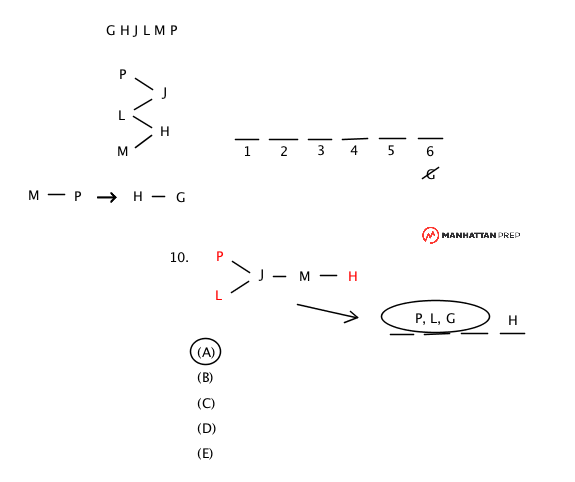
LSAT Forum
3 postsPage 1 of 1
-

- ManhattanPrepLSAT1
-
Thanks Received: 1909
-
Atticus Finch

- Posts: 2851
- Joined: October 07th, 2009
-

- Rendona001
-
Thanks Received: 0
-
Vinny Gambini

- Posts: 8
- Joined: September 27th, 2016
Re: Q10
This game seemed ok to figure out with a few inferences but this question took me a bit longer to answer. So I get that L P M have to go before H J and the question says J - M so how could A be the answer? GLPHJM? Am I reading into this question too much?? 
Can someone explain the diagram and explanation above? Thank you!
Can someone explain the diagram and explanation above? Thank you!
-

- ohthatpatrick
-
Thanks Received: 3808
-
Atticus Finch

- Posts: 4661
- Joined: April 01st, 2011
- This post thanked 1 time.
Re: Q10
I can try to explain the diagram, but this typing environment makes it difficult to draw any new pictures.
Start with the rule given for Q10 and attach what we know for J and M
J - M
we also know M is before H, from rule 1, so
J - M - H
We know L and P are before J, from rule 2, so
(L and P) - J - M - H
That's 5 of our 6 people. Who's left? G.
Does he have an applicable rule?
Rule 3 does NOT apply to this question, because it is NOT the case that M is before P. So rule 3 evaporates for this problem.
We can put G anywhere but last (per rule 4).
So you have (L and P) - J - M - H
and G anywhere but last
note: the (L and P) notation I'm using is just my way of approximating the two pronged diagram shown in the image above.
L and P do NOT have to come attached at the hip, and they can come in either order.
What probably confused you is that this question stem is NOT asking us, "Which one of these could be spots 1, 2, 3, 4". Instead, it's just asking us in a more general way, "could these four people end up in this sequence?"
(A) is saying, "Can you get G - L - P - H"? Sure that doesn't contradict our setup.
(B) Can we get G - P - H - L? No, because the H - L contradicts that we have L - H.
(C) Can we get L - H - G - P? No, because the H - P contradicts that we have P - H.
(D) Can we get L - P - H - G? No, because if G is after H, then G is last.
(E) Same problem as D.
Hope this helps.
Start with the rule given for Q10 and attach what we know for J and M
J - M
we also know M is before H, from rule 1, so
J - M - H
We know L and P are before J, from rule 2, so
(L and P) - J - M - H
That's 5 of our 6 people. Who's left? G.
Does he have an applicable rule?
Rule 3 does NOT apply to this question, because it is NOT the case that M is before P. So rule 3 evaporates for this problem.
We can put G anywhere but last (per rule 4).
So you have (L and P) - J - M - H
and G anywhere but last
note: the (L and P) notation I'm using is just my way of approximating the two pronged diagram shown in the image above.
L and P do NOT have to come attached at the hip, and they can come in either order.
What probably confused you is that this question stem is NOT asking us, "Which one of these could be spots 1, 2, 3, 4". Instead, it's just asking us in a more general way, "could these four people end up in this sequence?"
(A) is saying, "Can you get G - L - P - H"? Sure that doesn't contradict our setup.
(B) Can we get G - P - H - L? No, because the H - L contradicts that we have L - H.
(C) Can we get L - H - G - P? No, because the H - P contradicts that we have P - H.
(D) Can we get L - P - H - G? No, because if G is after H, then G is last.
(E) Same problem as D.
Hope this helps.
3 posts Page 1 of 1